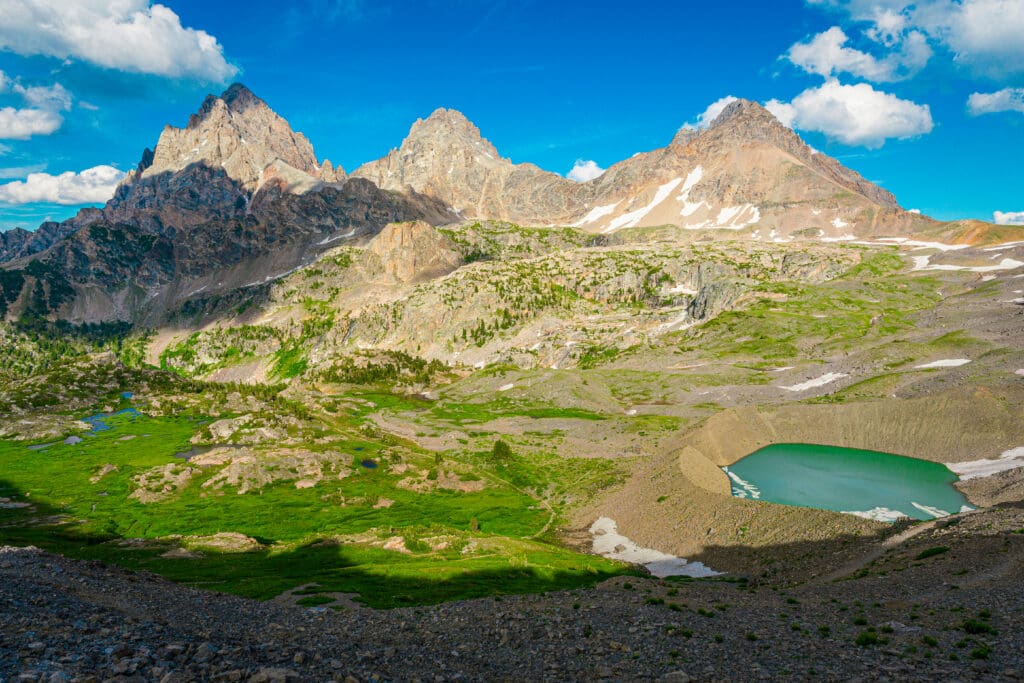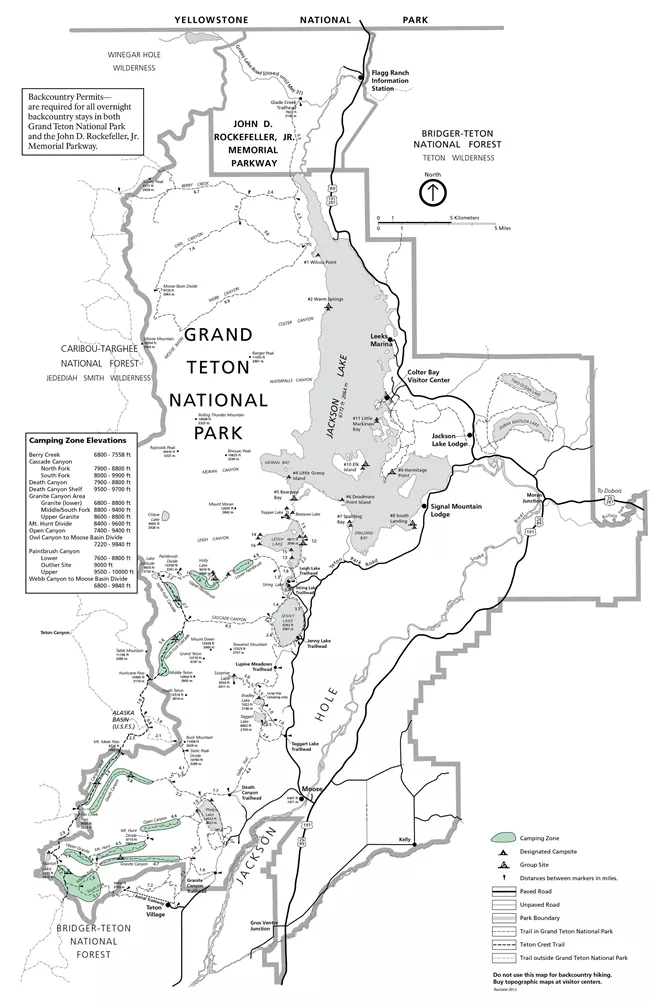Embark on the Teton Crest Trail for a 40-mile adventure through Grand Teton National Park, where towering peaks, alpine lakes, and wildflower meadows create a stunning and unforgettable wilderness experience. Embrace nature’s beauty and challenges.
Overview
The Teton Crest Trail is one of the premier backpacking routes in the United States, renowned for its breathtaking scenery and challenging terrain. Spanning approximately 40 miles (64 kilometers), the trail traverses the backbone of the Teton Range, offering hikers unparalleled views of jagged peaks, verdant meadows, and crystal-clear alpine lakes. With an elevation gain of approximately 8,000 feet (2,438 meters), the trail is typically completed in four to six days, depending on the pace and experience level of the hikers.
The journey begins at the Phillips Pass Trailhead and ends at the String Lake Trailhead, although some variations and alternative routes are available. Along the way, hikers pass through iconic landmarks such as Death Canyon Shelf, Alaska Basin, and Hurricane Pass. The highest point on the trail is Paintbrush Divide at 10,700 feet (3,261 meters). Each section of the trail presents unique challenges and rewards, making the Teton Crest Trail a must-do for avid backpackers.

Teton Crest, Grand Teton National Park.
Getting to the Trailhead
The Teton Crest Trail can be accessed from several trailheads, with the most popular starting point being the Phillips Pass Trailhead. To reach this trailhead, hikers typically fly into Jackson Hole Airport, located approximately 20 miles from Grand Teton National Park. From the airport, it’s a scenic drive through the park to the trailhead.
Phillips Pass Trailhead: The Phillips Pass Trailhead is situated at an elevation of 8,400 feet and provides a direct entry into the heart of the Teton Crest Trail. The trailhead is accessible via Highway 22 from Jackson, Wyoming, followed by a drive on the unpaved but well-maintained Teton Pass Road. Parking is available at the trailhead, but spaces can fill up quickly during peak season, so early arrival is recommended.
Granite Canyon Trailhead: An alternative starting point is the Granite Canyon Trailhead, located near Teton Village. This trailhead offers a slightly longer approach but provides a more gradual ascent into the Teton Crest Trail. To reach this trailhead, hikers can take the Jackson Hole Aerial Tram to the top of Rendezvous Mountain and then hike down to Granite Canyon, or they can hike directly from Teton Village.
Death Canyon Trailhead: The Death Canyon Trailhead is another option for accessing the Teton Crest Trail. Located near the White Grass Ranger Station, this trailhead involves a steep climb up to Death Canyon Shelf, where hikers can connect with the main trail. This route is more strenuous but rewards hikers with stunning views of Death Canyon and the surrounding peaks.
Jackson Hole Mountain Resort Tram: For a more unique entry, take the aerial tram from Teton Village up to Rendezvous Mountain. This option skips some of the initial climbing and starts you off with high-altitude vistas right away.
Transportation to and from the trailheads can be arranged through local shuttle services or by parking a vehicle at one of the designated parking areas. It’s important to plan transportation logistics in advance, as parking can be limited during peak hiking season.
Places to Stay
While the Teton Crest Trail is primarily a backcountry experience, there are several accommodation options for hikers before and after their trek. In Jackson, Wyoming, a variety of hotels, lodges, and campgrounds are available to suit different budgets and preferences. Some popular options include the Jackson Lake Lodge, Jenny Lake Lodge, and the Signal Mountain Lodge.
Jackson Lake Lodge: Jackson Lake Lodge, located within Grand Teton National Park, offers stunning views of the Teton Range and is an ideal place to stay before or after your trek. The lodge features comfortable rooms, dining options, and easy access to various park activities. It’s a great place to relax and recharge after a challenging hike.
Jenny Lake Lodge: Jenny Lake Lodge provides a more intimate and luxurious stay, with rustic cabins nestled in a serene forest setting. The lodge offers fine dining, guided activities, and proximity to some of the park’s most popular attractions, including Jenny Lake and the Cascade Canyon.
Signal Mountain Lodge: For a more budget-friendly option, Signal Mountain Lodge offers a range of accommodations from rustic cabins to campsites. The lodge is located on the shores of Jackson Lake, providing easy access to boating, fishing, and hiking. It’s a perfect base for exploring the park and preparing for the Teton Crest Trail.
Backcountry Camping
For those looking to camp along the trail, backcountry permits are required and can be obtained from the park’s visitor centers. The park has designated camping zones along the trail, including sites at Marion Lake, Death Canyon Shelf, and Alaska Basin. These campsites offer stunning views and a chance to immerse oneself in the natural beauty of the park.
On the Teton Crest Trail, there are 11 designated campsites available for backpackers. These sites operate on a first-come, first-serve basis for groups of six or less after obtaining a permit. For larger groups, there are specific group sites marked with signs that can only be used by designated permit-holders. To learn more about the backcountry campsites, visit the NPS website. The individual campsites include Cascade Canyon (North and South Forks), Death Canyon, Garnet Canyon, Granite & Open Canyon, Holly Lake, Lower Paintbrush, Marion Lake, Phelps Lake, Upper Paintbrush, and Surprise Lake.
Marion Lake: Marion Lake is a popular first-night campsite, offering a peaceful setting and stunning views of the surrounding peaks. The lake is a great spot for a refreshing swim after a day of hiking, and the nearby meadows are often filled with wildflowers in the summer.
Death Canyon: Camping on Death Canyon provides hikers with breathtaking views of the canyon and the Teton Range. The shelf is an exposed, high-altitude area, so be prepared for changing weather conditions. The sunrise and sunset views from this campsite are truly spectacular.
Teton National Park has provided a map of the Teton Crest Trail, displaying the distances between campsites and the overall elevation of the route.

Map: NPS
Field Notes
Trail Conditions and Weather
The Teton Crest Trail is best hiked from late July to early September, when the snow has melted and the weather is most favorable. However, even during this period, hikers should be prepared for rapidly changing conditions. Afternoon thunderstorms are common, and temperatures can vary significantly between day and night.
Trail conditions can range from well-maintained paths to rocky and uneven terrain. Hikers should be prepared for steep ascents and descents, particularly in areas like Paintbrush Divide and Hurricane Pass. Proper footwear and trekking poles are highly recommended to navigate the challenging terrain.
Wildlife and Flora
Grand Teton National Park is home to a diverse array of wildlife, including black bears, moose, elk, and marmots. Hikers should take precautions to store food properly and carry bear spray. The park’s wildflower meadows are particularly stunning in mid-summer, with species such as Indian paintbrush, lupine, and alpine forget-me-nots adding vibrant colors to the landscape.
Water Sources
Water sources are plentiful along the trail, with numerous streams and alpine lakes providing opportunities to refill. However, all water should be treated or filtered before consumption to prevent waterborne illnesses. Hikers should plan their water resupply points in advance, particularly in dry sections of the trail.
Altitude and Acclimatization
The Teton Crest Trail reaches elevations of over 10,000 feet, so hikers should be aware of the potential for altitude sickness. Proper acclimatization is important, and it’s recommended to spend a few days at higher elevations before starting the trek. Hydration, nutrition, and pacing are key to preventing altitude-related issues.
Journal
Day 1: Phillips Pass Trailhead to Marion Lake
The adventure begins at the Phillips Pass Trailhead, where the initial climb quickly reveals stunning views of the Teton Range. The trail meanders through lush forests and open meadows, gradually gaining elevation. After a challenging ascent, we reach Marion Lake, our first campsite. The lake is a serene oasis, reflecting the towering peaks that surround it. Setting up camp, we take in the beauty of the landscape and enjoy a well-deserved rest after our first day on the trail.
Day 2: Marion Lake to Death Canyon Shelf
Leaving Marion Lake, we continue our journey along the Teton Crest Trail. The trail traverses Death Canyon Shelf, offering panoramic views of the valley below. The wildflower meadows are in full bloom, painting the landscape with vibrant colors. We set up camp on the shelf, with the imposing peaks of the Tetons as our backdrop. As the sun sets, the sky is painted with hues of pink and orange, creating a magical atmosphere that highlights the beauty of this remote area.
Day 3: Death Canyon Shelf to Alaska Basin
The trail descends into the stunning Alaska Basin, a high-altitude plateau dotted with alpine lakes and granite outcroppings. The terrain is rugged but incredibly rewarding, with breathtaking vistas at every turn. We camp near Sunset Lake, enjoying a spectacular sunset that bathes the landscape in warm hues. The clear night sky reveals a blanket of stars, and we fall asleep to the soothing sounds of nature.
Day 4: Alaska Basin to Hurricane Pass
Leaving Alaska Basin, we ascend to Hurricane Pass, one of the most challenging sections of the trail. The climb is steep and strenuous, but the views from the pass are unparalleled. The Grand Teton looms majestically in the distance, and we can see for miles in every direction. We descend into the South Fork Cascade Canyon, finding a peaceful campsite by a babbling brook. The sense of isolation and tranquility here is profound, allowing us to fully disconnect from the outside world.
Day 5: South Fork Cascade Canyon to North Fork Cascade Canyon
Our journey continues through the lush and vibrant South Fork Cascade Canyon. The trail winds through dense forests and along cascading waterfalls, offering a stark contrast to the high alpine terrain we’ve traversed so far. We take our time, enjoying the cooler temperatures and abundant shade. As we make our way to the North Fork Cascade Canyon, the scenery shifts once again, with towering granite walls and expansive meadows. We find a secluded campsite and settle in for the night, reflecting on the diverse landscapes we’ve encountered.
Day 6: North Fork Cascade Canyon to String Lake Trailhead
Our final day on the trail takes us through the beautiful Cascade Canyon, with its lush vegetation and cascading waterfalls. The trail eventually levels out as we approach String Lake, where our journey concludes. The sense of accomplishment is palpable as we reflect on the incredible landscapes we’ve traversed and the challenges we’ve overcome. We take a moment to soak our tired feet in the cool waters of String Lake, savoring the last moments of our adventure.
Conclusion
The Teton Crest Trail is a journey of a lifetime, offering hikers a chance to experience the raw beauty of Grand Teton National Park. From towering peaks to tranquil alpine lakes, the trail presents a diverse array of landscapes that captivate the senses and challenge the spirit. Whether you’re an experienced backpacker or a novice hiker, the Teton Crest Trail promises an unforgettable adventure.
Preparation is key to a successful trek, including securing permits, planning logistics, and ensuring you have the proper gear. With careful planning and a sense of adventure, the Teton Crest Trail can provide a wilderness experience like no other, leaving you with memories that will last a lifetime.
Embark on this journey with respect for the natural world and a readiness to embrace the challenges and rewards of the trail. The Teton Crest Trail awaits, offering a truly extraordinary adventure in the heart of the American wilderness.
Popular Articles:
Adventurer’s Guide to Grand Teton National Park, Wyoming
Planning the Perfect Adventure Trip to Jackson Hole, Wyoming
Adventurer’s Guide to Death Valley National Park, California
Planning the Perfect Adventure Trip to Crested Butte, Colorado











